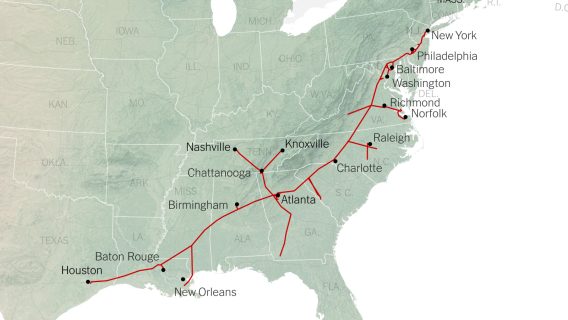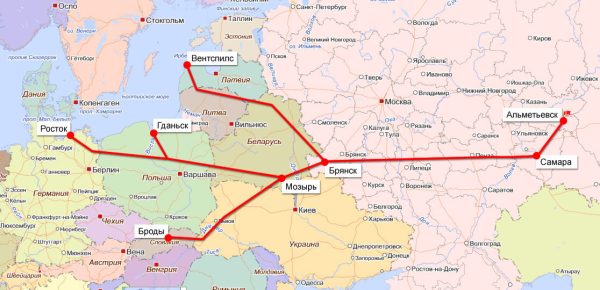Oil and natural gas are necessary resources as they provide over half of the world’s energy. A lack of oil and natural gas would have a country, and the world, crumbling to a halt. Pipelines are the most energy-efficient, safe, environment-friendly, and economical way to transport this commodity over long distances, either within the geographical boundary of a country or beyond.
There are two types of pipelines that transport oil in the world. These are the crude oil pipelines and product pipelines. Crude oil pipelines carry crude oil to refineries, while product pipeline transport refined products. The latter include gasoline, kerosene, jet fuel, and heating oil from refineries to the market. In this article, we look at the longest oil pipelines in the world.
List of the top 5 longest oil pipelines in the world
- Colonial Pipeline in the Americas (length 8, 850 kilometres)
- Druzhba pipeline in Europe (length 5,500 kilometres)
- Eastern Siberia-Pacific Ocean Oil Pipeline in Asia (length 4,857 kilometres)
- Keystone Pipeline in the Americas (length 4,700 kilometres)
- Kazakhstan-China Pipeline in Asia (length 2,228 kilometres)
1. Colonial Pipeline

The 8,850-kilometer Colonial Pipeline is the largest pipeline system for oil or rather refined oil products in the U.S.
Consisting of three tubes, the pipeline originates in Houston, Texas, on the coast of the Gulf of Mexico and terminates at the Port of New York and New Jersey. It cuts across the coastal states of Texas, Louisiana, Mississippi, Alabama, Georgia, South Carolina, North Carolina, Virginia, Maryland, Delaware, Pennsylvania, and New Jersey. Branches from the main Colonial Pipeline also reach Tennessee, a landlocked state in the Southeastern region of the United States.
The main Colonial Pipeline lines are 40 inches and 36 inches in (inner) diameter. One of the lines is devoted primarily to gasoline while the other carries distillate products such as jet fuel, diesel fuel, and home heating oil. Products move through the main lines at a rate of approximately 3 to 5 miles per hour, the equivalent of 4.8 to 8.0 km/h. On a daily basis, the pipeline delivers an average of 1×108 US gallons, the equivalent of 3.8×108 L of gasoline, home heating oil, aviation fuel and other refined petroleum products to communities and businesses throughout the South and Eastern United States.
Overall, the Colonial Pipeline has the capacity to carry about 3 million barrels of fuel per day.
Also Read: The longest natural gas pipelines in the world
2. Druzhba Pipeline

Also referred to as the Friendship Pipeline and the Comecon Pipeline, the Druzhba Pipeline is the second-longest and one of the largest oil pipelines in the world.
The pipeline begins at Almetyevsk in the Russian Federation, where pipelines carrying crude oil from Siberia, the Urals and the Caspian Sea meet. From Almetyevsk, the pipeline runs to Mozyr in Belarus. Here it splits into a northern and a southern branch with the northern branch continuing through Belarus and Poland to Germany. The southern branch on the other hand runs through Ukraine, splitting at Uzhgorod into Druzhba 1 and Druzhba 2. Druzhba 1 continues to Slovakia where it splits again and goes to the Czech Republic in one branch and Hungary in another. Druzhba 2 proceeds to Hungary.
The entire Druzhba pipeline is approximately 5500 kilometres long including all its branches while its current capacity is 1.2–1.4 million barrels a day. Reportedly, there is a possibility to increase the capacity of the pipeline up to 2 million barrels a day.
3. Eastern Siberia-Pacific Ocean Oil Pipeline

The Eastern Siberia–Pacific Ocean Oil Pipeline (ESPO Pipeline or ESPOOP) is a pipeline system for exporting Russian crude oil to the Asia-Pacific markets i.e. Japan, China and Korea.
The 4,857 kilometres long pipeline was built between 2006 and 2012 in two phases. The first phase involved the construction of a 2,757-kilometre section from Taishet in Irkutsk Oblast to Skovorodino in Amur Oblast, along with a branch from Skovorodino to Daqing, China. This section of the pipeline has a diameter of 48 inches and annual crude oil transfer capacities of 80 million tonnes.
The second phase on the hand involved the construction of an approximately 2,100-kilometre section from Skovorodino to the Pacific Ocean terminal at Kozmino. The section from Skovorodino to Khabarovsk features 1,067mm diameter pipes, whereas the section from Khabarovsk to Kozmino features 1,020mm diameter pipes.
4. Keystone Pipeline

This is 4700 kilometres oil pipeline system in Canada and the United States. The pipeline runs from the Western Canadian Sedimentary Basin in Alberta to refineries in Illinois and Texas. Additionally, it extends to oil tank farms and an oil pipeline distribution centre in Cushing, Oklahoma.
The Keystone Pipeline was delivered in three phases. The first phase which is 3,456 kilometres long runs from Hardisty, Alberta, to the junction at Steele City, Nebraska. It then proceeds on to the Wood River Refinery in Roxana, Illinois, and Patoka Oil Terminal Hub (tank farm) north of Patoka, Illinois. The second phase connects Phase 1 in Steele City, Nebraska, south through Kansas to the oil hub and tank farm in Cushing, Oklahoma. It covers a distance of 468 kilometres.
The third phase was delivered in two subsections. Phase 3a started at Cushing, Oklahoma, where American-produced oil is added to the pipeline, then runs south for about 700 kilometres to a delivery point near terminals in Nederland, Texas. Phase 3b on the other hand is a 76 kilometers pipeline that transport crude oil from the pipeline in Liberty County, Texas, to refineries and terminal in the Houston area.
Keystone Pipeline would probably be the second longest oil pipeline in the world, were it not for the cancellation of its 526 kilometres 4th phase.
5. Kazakhstan-China Pipeline
Owned by the China National Petroleum Corporation (CNPC) and the Kazakh oil company KazMunayGas, Kazakhstan–China oil pipeline is considered China’s first direct oil import pipeline allowing oil import from Central Asia.
The 2,228 kilometres long pipeline runs from Atyrau in Kazakhstan to Alashankou in China’s Xinjiang. The Kenkiyak-Atyrau section of the pipeline is approximately 449 kilometres long. The Atasu-Alashankou section of the pipeline on the other hand is 987 kilometres long while the Kenkiyak-Kumkol section is 792 kilometres long.
The construction of the Kazakhstan-China pipeline was proposed by Kazakhstan and agreed upon between China and the former back in 1997.

